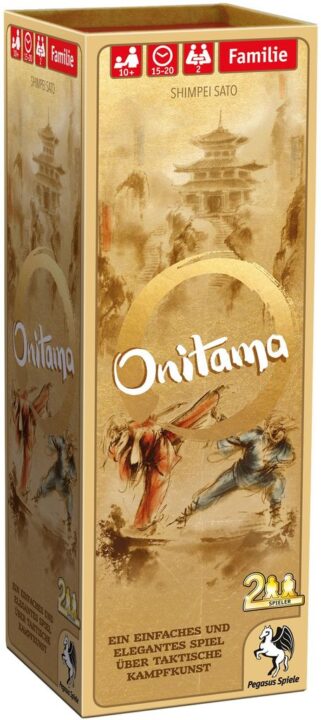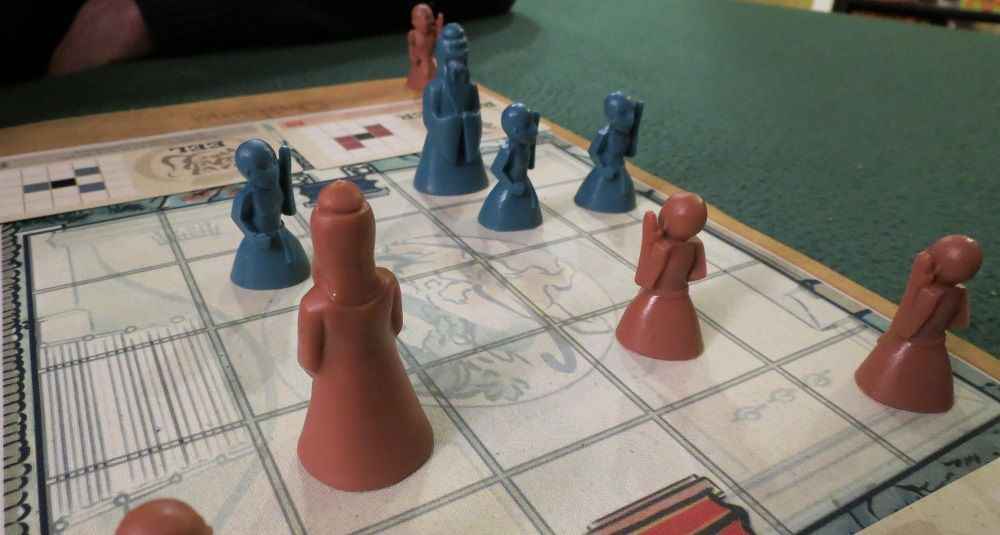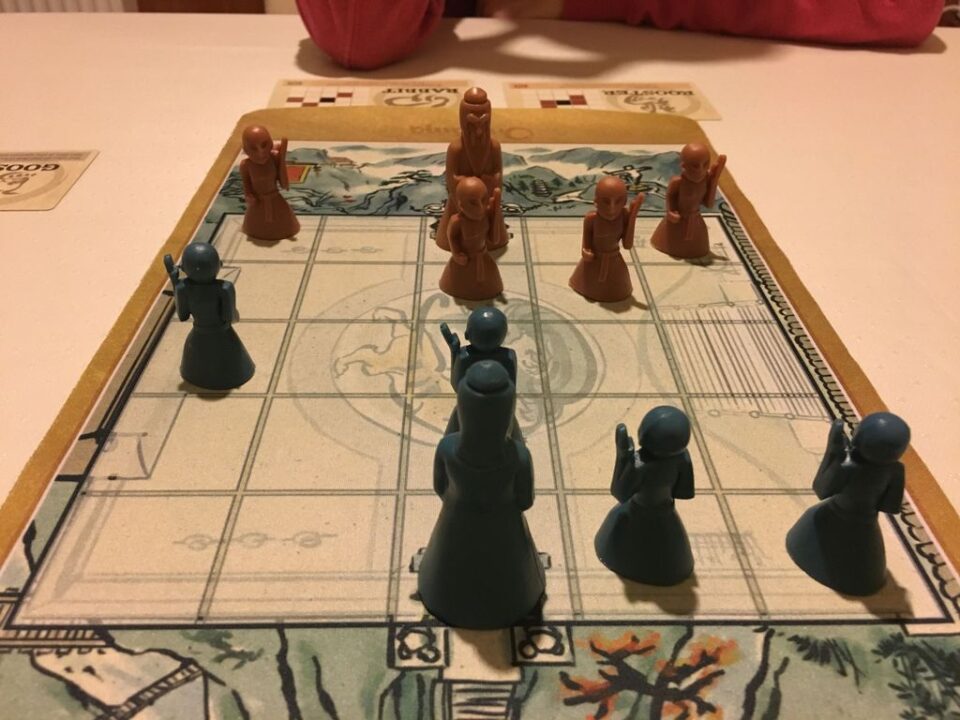Overview
In today’s world of board gaming, where complexity often equates with depth, it is a delightful surprise when a title like Onitama arrives and flips the script. What we have here is my review of a game that hides layers of strategy behind a veil of simplicity. Just when you think you’ve mastered its dances, Onitama subtly reminds players that it’s not the rules themselves, but the way players engage with them, that crafts an unforgettable experience. The art of movement within a confined space, tied to a deck of cards, turns every match into a new puzzle where human interaction takes center stage. Join me as we explore how Onitama’s minimalist approach makes every session a riveting journey through ancient martial tactics distilled into a modern board game classic.
How It Plays
Onitama captures the imagination with its elegant simplicity and intellectual dueling spirit. It’s perfect for players who appreciate chess-like tactics with a quicker gameplay loop.
Setting Up
Setup is a breeze. Roll out the mat representing the board, take the minimalist set of pieces for each player, and shuffle the all-important move cards. You randomly deal two cards to each player and place one card aside as the future move. In under five minutes, you’re ready to dive into a world of ancient martial arts rivalry.
Gameplay
The beauty of the game flourishes during play. You are in a state of constant change, alternating moves with cards dictating the movement of your pieces. With every move card used, strategy must be reassessed, making for a dynamic, highly engaging game that will have players leaning in closer with every turn.
Winning the Game
To claim victory, maneuver your Sensei into the opponent’s temple arch or capture the opposing Sensei – a test of foresight and cunning. Each game is a dance of the minds, where one oversight can pivot the path to triumph.
Want to know more? Read our extensive strategy guide for Onitama.
Onitama Review: The Delicate Dance of Simplicity and Depth
Peering into the realm of board game design, one often marveled aspect is the grace at which a game balances straightforward rules with profound strategic depths. Onitama, a succinct abstract strategy game, exemplifies this harmony. Rule Simplicity acts not as a limitation but rather as a catalyst for deeper tactical play. First-time players find themselves comfortably acquainted within minutes, the lean instruction manual fostering a near-instant commune with the game’s mechanics.
Mechanics That Matter
Transitioning from raw tutorial to fierce competition is seamless. Each move in Onitama carries substantial weight—specifically because there are so few of them. The five-card play system instills a sense that no piece operates independently; every stretch, slide, and advance are deliberate, pivotal to the end game.
Strategies Unfurl
Ironically, the constraint inherent within Onitama’s framework only amplifies tactical possibilities. Veterans and newcomers alike grapple with not only balking their opponent’s path to enlightenment but also paving their own, often confronting the perils of overcommitting pieces or misreading the opponent’s intentions. A constant pendulum swing of attack and defense ensues, digging into that coveted depth that experienced players cherish without deterring novices.
Clicking into place, Onitama’s dance balances its accessible core with demanding mastery. Consequently, the game reserves a spot among the elite engagements that respect a player’s time without compromising complexity. And just as the rules gently pull you into its world, so does it invite you to partake in the rich tapestry of Player engagement and interaction, which our next section will excitingly unravel.
The Heartbeat of Onitama: Player Dynamics
Moving beyond the straightforward rules of Onitama, let’s delve into the crucible that really heats up the gameplay: player engagement and interaction. Immediately, from the opening move, players are thoroughly enmeshed in a silent dialogue of wit and anticipation.
A Dance of Minds
As I parsed through interactions during my Onitama Review endeavors, the beauty of the game’s social architecture unfurled. Players are not merely opponents; they become dance partners in a ballet of battle positioning. This constant back-and-forth, fueled by only a handful of moves at any given time, fosters a dense, shared experience. And transition words like ‘however’ and ‘therefore’ underscore the responsive nature of game sessions. Indeed, bodies lean in, players lock eyes, and laughs often escape at the sheer audacity of a move not previously considered.
A Mat of Togetherness
Moreover, each game of Onitama naturally constructs a social framework, a miniature community around the cloth mat. My experiences saw strangers offering cheers, friends delving into light-hearted banter, and non-players eagerly observing the strategic pantomime unfold. Thus, Onitama champions not just strategy, but also social bonds through its intricate simplicity. Victory can hinge on a single interaction, making every move a shared breath of exhilaration.
To draw the curtain back even further, the succeeding section will leap into the tactical dance itself—as we explore the waltz of spacial consideration in Tactical movement and strategy.

The Intellectual Dance of Onitama
In every Onitama Review, tactical movement and strategy take center stage. As the pillars that elevate this game from good to remarkable, the intellectual challenge they provide can’t be overstated. First, let’s crack open the essence of tactical maneuvering.
Masterful Maneuvers
Onitama’s board is a grid where every move is a potential game changer. Players need to think ahead, anticipating both theirs and their opponent’s cards. Each creature card in hand requires analysis — much like in chess, except here, your moves are dictated by the ever-changing rotation of available actions. This system ensures a fresh strategy with each play, keeping the mind in a constant state of agile adaptation.
Strategic Symphony
Deeper still is the symphony of strategy. It’s about recognizing patterns and building a plan. That moment when you’ve outmaneuvered your rivals, effectively deploying the Dragon or Rabbit maneuvers, securing a path to claim the Shrine or capture the Master – sheer satisfaction follows.
In conclusion, if a richly deep yet accessible abstract experience is what you seek, Onitama sincerely gets a thumbs-up. Its melody of strategy woven with tactical grace makes it a dance well worth joining on any game night.

Conclusion
In wrapping up this Onitama review, it’s clear that this game masterfully connects simplicity with enjoyable depth. Through its concise ruleset, swift gameplay, and the unfolding layers of strategic warfare, Onitama provides a battlefield where minds can duel in a remarkably accessible format. Alongside this, it thrives at knitting together social interaction, encouraging players to engage not just in silent contemplation but in vibrant banter and tactical discussions. The brilliance of Onitama lies in weaving these strands together to create a game that is as engaging to play as it is to discuss post-match. Whether you are a dedicated strategist or a casual gamer looking for a quick battle of wits, Onitama stands as a strong recommendation. It delivers on all the aspects one would hope for in a succinct yet profoundly engaging board game experience, making it worthy of space on any gamer’s shelf.



